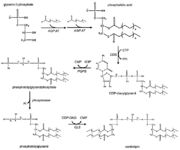User:Tereza Čalounová/Sandbox 1
From Proteopedia
m |
|||
| Line 29: | Line 29: | ||
*regulation of gene expression | *regulation of gene expression | ||
*skeletal muscle tissue development <ref name="cit5" /> | *skeletal muscle tissue development <ref name="cit5" /> | ||
| + | |||
=== Cardiolipin === | === Cardiolipin === | ||
Cardiolipin is a trivial name used for 1,3-bis(sn-3’-phosphatidyl)-sn-glycerol. <ref name="cit12">http://www.lipidhome.co.uk/lipids/complex/dpg/index.htm</ref> It is a phospholipid mostly found in the inner membrane of mitochondria where is essential for stability of enzymes which are part of the energy metabolism. Cardiolipin is also involved in different stages of the mitochondrial apoptotic process and in mitochondrial membrane dynamics. <ref name="cit13">https://link.springer.com/article/10.1007%2Fs00018-008-8030-5</ref> | Cardiolipin is a trivial name used for 1,3-bis(sn-3’-phosphatidyl)-sn-glycerol. <ref name="cit12">http://www.lipidhome.co.uk/lipids/complex/dpg/index.htm</ref> It is a phospholipid mostly found in the inner membrane of mitochondria where is essential for stability of enzymes which are part of the energy metabolism. Cardiolipin is also involved in different stages of the mitochondrial apoptotic process and in mitochondrial membrane dynamics. <ref name="cit13">https://link.springer.com/article/10.1007%2Fs00018-008-8030-5</ref> | ||
| + | |||
==== Structure ==== | ==== Structure ==== | ||
[[Image:CardiolipinStructure.png|thumb|Chemical structure of cardiolipin where R1-R4 are alkyl groups, typically 18-carbon fatty acid side chains. <ref name="cit14">https://commons.wikimedia.org/wiki/File:Cardiolipin_structure.svg?uselang=cs</ref>]] | [[Image:CardiolipinStructure.png|thumb|Chemical structure of cardiolipin where R1-R4 are alkyl groups, typically 18-carbon fatty acid side chains. <ref name="cit14">https://commons.wikimedia.org/wiki/File:Cardiolipin_structure.svg?uselang=cs</ref>]] | ||
| Line 46: | Line 48: | ||
==== Function ==== | ==== Function ==== | ||
| + | As mentioned, cardiolipin is mainly located on the mitochondrial inner membrane, but is also present on the outer mitochondrial membrane. Cardiolipin is essential for some enzyme systems such as energy metabolism, membrane transport and cell division. For example, when the apoptosis, programmed cell death, or mitophagy, mitochondrial degradation, is needed, cardiolipin is externalized on the surface of mitochondria and acts like a signaling molecule. <ref name="cit12" /> | ||
| + | On top of that, cardiolipin has many other functions. It is an important cofactor for cholesterol translocation from the outer to the inner mitochondrial membrane. It also has a role in the regulation of gene expression. What’s more, it can act like a molecular chaperone, so it helps mitochondrial proteins with folding. <ref name="cit13" /> | ||
| + | |||
== TAZ gene == | == TAZ gene == | ||
Tafazzin is encoded by a TAZ gene (G4.5). This gene is located on the long arm of the X chromosome at position 28 (Xq28). <ref name="cit6">https://ghr.nlm.nih.gov/gene/TAZ#location</ref> | Tafazzin is encoded by a TAZ gene (G4.5). This gene is located on the long arm of the X chromosome at position 28 (Xq28). <ref name="cit6">https://ghr.nlm.nih.gov/gene/TAZ#location</ref> | ||
Revision as of 18:26, 27 April 2019
This is our page where we will share informations about protein Tafazzin as a part of a school project with my classmates. This page is under a construction so please be aware of it. Zde přidám úvod
Tafazzin
| Theoretical Model: The protein structure described on this page was determined theoretically, and hence should be interpreted with caution. |
Tafazzin is a protein located in mitochondrial inner membranes. It is involved in altering cardiolipin. Cardiolipin is key in maintaining mitochondrial shape, energy production, and protein transport within cells. The full-length tafazzin protein contains 292 amino acids and has a molecular weight of 33459 daltons. Mutations in gene associated with this protein can cause Barth Syndrome. Barth syndrome (BTHS),is a genetic disorder diagnosed almost exclusively in males. BTHS is rare, it is estimated to affect 1 in 300,000 to 400,000 individuals worldwide. Males with BTHS have weak heart and skeletal muscles which can lead to heart failure. Another of the symptoms is neutropenia which can lead to infections. [1]
| |||||||||||
References
- ↑ https://ghr.nlm.nih.gov/condition/barth-syndrome#
- ↑ 2.0 2.1 https://www.uniprot.org/uniprot/Q16635?fbclid=IwAR3v10lUTRZfb0NFOYKC4wjaherdU9PIVJ8T63jkC9RfNu_5OQ2IpoDR0iY
- ↑ 3.0 3.1 3.2 3.3 http://www.lipidhome.co.uk/lipids/complex/dpg/index.htm
- ↑ 4.0 4.1 4.2 4.3 https://link.springer.com/article/10.1007%2Fs00018-008-8030-5
- ↑ https://commons.wikimedia.org/wiki/File:Cardiolipin_structure.svg?uselang=cs
- ↑ https://commons.wikimedia.org/wiki/File:Eukaryotic_pathway.jpg
- ↑ 7.0 7.1 https://www.ncbi.nlm.nih.gov/pmc/articles/PMC4342993/
- ↑ https://ghr.nlm.nih.gov/gene/TAZ#location
- ↑ 9.0 9.1 https://www.uniprot.org/uniprot/Q16635
- ↑ https://www.ncbi.nlm.nih.gov/pmc/articles/PMC4412953/
- ↑ 11.0 11.1 https://ghr.nlm.nih.gov/condition/barth-syndrome#
- ↑ 12.0 12.1 https://www.sciencedirect.com/science/article/pii/S092544391830334X?via%3Dihub
- ↑ 13.0 13.1 13.2 https://obgyn.onlinelibrary.wiley.com/doi/full/10.1002/pd.2599
- ↑ https://www.sciencedirect.com/topics/biochemistry-genetics-and-molecular-biology/tafazzin
- ↑ 15.0 15.1 15.2 https://www.ncbi.nlm.nih.gov/books/NBK247162/
- ↑ http://pfam.xfam.org/protein/Q16635

